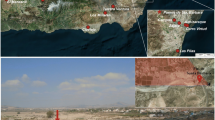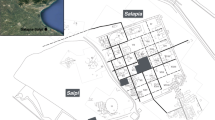Abstract
The Bracarense ceramics are characterized by a fine, pale yellow paste covered with a brownish yellow slip. The name is derived from Bracara Augusta, the Roman town located in the north of Portugal, where this type of ceramic paste was first found and identified. Various forms with the same type of paste occur, such as imitations of sigillata, terra sigillata and thin walls from the Augustus-Tiberius period, and common ware. Later, similar ceramics were also found in other archeological sites, e.g. Aquis Querquennis (Galiza, Spain), which question the location of the production center of this type of ceramic paste.
Mineralogical and chemical analyses showed that the majority of the Bracarense shards studied differ from the common ware of the Braga region. Despite minor differences, the Bracarense shards collected in Aquis Querquennis have the same geochemical pattern as those found in Bracara Augusta, i.e. they appear to have been manufactured with the same clay type. The firing products found indicate a kaolin character of the source clay, and point to firing temperatures near 900°C. The Aquis Querquennis shards have greater Br contents, which can be explained by use-wear and/or post-depositional processes, as this site is located in a thermal-water region.
Similar content being viewed by others
References
Alarcão, A.M. and Martins, A.N. (1976) Uma cerâmica aparentada com as ‘Paredes Finas’ de Mérida. Conimbriga, XV, Coimbra, 91–109.
Bates, T.F. (1971) The kaolin minerals. Pp. 109–157 in: The Electron-Optical Investigation of Clays (J.A. Gard, editor). Monograph 3, Mineralogical Society, London.
Baumgart, W., Dunham, A.C. and Amstutz, G.C. (editors) (1984) Process Mineralogy of Ceramic Materials, Ferdinand Enke Publishers, Stuttgart, Germany.
Brown, G. (1980) Associated Minerals. Pp. 361–410 in: Crystal Structures of Clay Minerals and their X-ray Identification (G.W. Brindley and G. Brown, editors). Monograph 5, Mineralogical Society, London.
Brown, G. and Brindley, G.W. (1980) X-ray diffraction procedures for clay mineral identification. Pp. 305–360 in: Crystal Structures of Clay Minerals and their X-ray Identification (G.W. Brindley and G. Brown, editors). Monograph 5, Mineralogical Society, London.
Carty, W.M. and Senapti, U. (1998) Porcelain — raw materials, processing phase evolution, and mechanical behavior. Journal of the American Ceramic Society, 81, 3–20.
Ferreira, N., Dias, G., Meireles, C. and Sequeira Braga, M.A. (2000) Carta Geológica de Portugal na escala 1/50 000. Notícia Explicativa da Folha 5-D, Braga, 2a edição, IGM, Lisboa, 68 pp.
Gaspar, A. (2000) Contribuição para o estudo de cerâmicas dos séc. V–VI DC de Braga. M.Sc. thesis, Universidade do Minho, Portugal, 93 pp.
Gomes, A. (2000) Cerâmicas pintadas da época romana: tecnologia, tipologia e cronologia. M.Sc. thesis, Universidade do Minho, Portugal, 93 pp.
Gomes, C. (1988) Argilas. O que sâo e para que servem. Fundação Calouste Gulbenkian, Lisboa, 457 pp.
Gouveia, M.A., Prudêncio, M.I., Freitas, M.C., Martinho, E. and Cabral, J.M.P. (1987) Interference from uranium fission products in the determination of rare earths, zirconium and ruthenium by instrumental neutron activation analysis in rocks and minerals. Journal of Radioanalytical and Nuclear Chemistry, Articles, 114, 309–318.
Govindaraju, K. (1994) Compilation of working values and sample description for 383 geostandards. Geostandards Newsletter, 18, 1–7.
Hervés Raigoso, F.M. (1989) Escavacion arqueolóxica do campamento Romano de ‘Aquis Querquennis’ (Bande, Ourense). Arqueoloxía. Informes 3. Campaña 1989, Xunta de Galicia, pp. 45–49.
ITGE (1989) Mapa geológico de España. Escala 1:200 000, Hoja no 17/27, Ourense/Verin, Madrid, 284 pp.
Martinho, E., Gouveia, M.A., Prudêncio, M.I., Reis, M.F. and Cabral, J.M.P. (1991) Factor for correcting the ruthenium interference in instrumental neutron activation analysis of barium in uraniferous samples. Applied Radiations and Isotopes, 42, 1067–1071.
Martins, M. and Delgado, M. (1989–90a) As necrópoles de Bracara Augusta: os achados arqueológicos. Cadernos de Arqueologia II, 6/7, Braga, pp. 41–186.
Martins, M. and Delgado, M. (1989–90b) História e Arqueologia de uma cidade em devir: Bracara Augusta. Cadernos de Arqueologia II, 6/7, Braga, 11–38.
Martins, M. and Delgado, M. (1995) Bracara Augusta: Uma cidade na periferia do império. Actas do Colóquio Internacional de Arqueologia ‘Los finisterres Atlânticos en la Antiguedad (época preromana y romana)’. Gijón, pp. 121–128.
Oliveira, F. (1997) Contribuição para o estudo da cerâmica fina de Braga. A cerâmica ‘dita Bracarense’. M.Sc. thesis, Universidade do Minho, Portugal, 93 pp.
Oliveira, F., Sequeira Braga, M.A., Prudêncio, M.I., Delgado, M. and Gouveia, M.A. (2005) The non vitrifiable red slip ware found in Braga (Northwest Portugal). A mineralogical and chemical understanding. Pp. 80–89 in: Understanding People through their Pottery (M.I. Prudêncio, M.I. Dias and J.J. Waerenborgh, editors). EMAC’03. Trabalhos de Arquelogia, Série Monográfica, IPA, Lisboa.
Prudêncio, M.I., Gouveia, M.A. and Cabral, J.M.P. (1986) Instrumental neutron activation analysis of two French geochemical reference samples — Basalt BR and Biotite Mica-Fe. Geostandards Newsletter, X, 29–31.
Prudêncio, M.I., Gouveia, M.A. and Cabral, J.M.P. (1988) Instrumental neutron activation analysis of NBS-97a Flint Clay and NBS-98a Plastic Clay reference samples with a view to their use as standards for archeological studies and clay studies. Journal of Trace and Microprobe Techniques, 6, 103–111.
Prudêncio, M.I., Cabral, J.M.P. and Tavares, A. (1989) Identification of clay sources used for Conímbriga and Santa Olaia pottery making. Proceedings of the 1986 Archaeometry Symposium (Y. Maniatis, editor), 503–514.
Rice, P.M. (1987) Pottery Analysis, A Sourcebook. The University of Chicago Press/Chicago and London, 559 pp.
Rodriguez Colmenero, A. (1983) El campamento romanao de ‘Aquis Querquennis’. Actas del II Seminario de Arqueología del Noroeste. Ministerio de Cultura, Santiago de Compostela, Madrid.
Sequeira Braga, M.A. (1988) Arenas e depósitos associados da bacia de drenagem do rio Cávado (Portugal) — Contribuição para o estudo da arenização. PhD thesis, Universidade do Minho, Portugal, 325 pp.
Sequeira Braga, M.A., Paquet, H. and Begonha, A. (2002) Weathering of granites in a temperate climate (NW Portugal): granitic saprolites and arenization. Catena, 49, 41–56.
Sinha, M.K. and Guha, S.K. (1992) Mineralogical studies on five plastic fire clays — DTA, TG and electron microscopy. Journal of Thermal Analysis, 38, 1405–1413.
StatSoft, Inc. (2003) STATISTICA (data analysis software system), version 6. https://doi.org/www.statsoft.com
Velde, B. and Druc, I.C (1999) Archaeological Ceramic Materials. Origin and utilization. Springer-Verlag, Berlin, Heidelberg, 299 pp.
Author information
Authors and Affiliations
Corresponding author
Rights and permissions
About this article
Cite this article
Prudêncio, M.I., Braga, M.A.S., Oliveira, F. et al. Raw material sources for the Roman Bracarense ceramics (NW Iberian Peninsula). Clays Clay Miner. 54, 638–649 (2006). https://doi.org/10.1346/CCMN.2006.0540510
Received:
Revised:
Published:
Issue Date:
DOI: https://doi.org/10.1346/CCMN.2006.0540510




